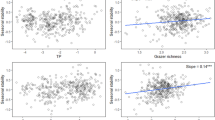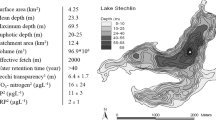Abstract
Major focus in interpreting phytoplankton changes in specific typologies of waterbodies or in single lakes is directed towards nutrients and climatic dynamics. During the last 35 years, Lake Garda (Northern Italy; A = 368 km2, z max = 350 m, V = 49 km3) underwent a significant increase of phosphorus in the water column, from ca. 10 μg P l−1 to 18–22 μg P l−1. At the multi-decadal scale, the increase of the trophic status had a positive impact on the growth of Cyanobacteria (mainly Oscillatoriales) and, partly, diatoms, as demonstrated by the long-term ecological research carried out since the beginning of the 1990s in the deepest zone of the lake. Conversely, the increase of Peridiniales (mostly Ceratium hirundinella) in the recent years appeared also associated with the interannual variations of lake temperature. At the seasonal and annual scale, the development of the large diatoms and Oscillatoriales during the periods of their maximum growth (early spring, and summer and autumn, respectively) was strongly controlled by the extent of spring vertical water mixing and nutrient fertilization of surface waters, which, in turn, were negatively dependent on the air and water temperatures in winter and early spring. Therefore, contrary to the positive impact of milder winters on phytoplankton growth in many lakes of high latitudes, warmer winter temperatures in deep oligomictic lakes of lower latitudes can determine periodic shifts towards more oligotrophic conditions and a minor development of diatoms and specific harmful cyanobacterial groups (Oscillatoriales). The complex relationships between the explanatory and response variables were tested by applying Path Analysis (Structural Equation Modeling). This multiequational technique has great potential for studying causal relationships in temporally ordered variables. The results highlight the necessity to study the consequences of climatic fluctuations on the phytoplankton communities at different temporal scales and complexity, also including the indirect effects of climatic dynamics mediated by the morphometric, morphological and hydrological characteristics of lakes, and the possible synergic or opposite effects with other forcing variables, including nutrients.




Similar content being viewed by others
References
Blenckner, T., 2005. A conceptual model of climate-related effects on lake ecosystems. Hydrobiologia 533: 1–14.
Blenckner, T., R. Adrian, D. M. Livingstone, E. Jennings, G. A. Weyhenmeyer, D. G. George, T. Jankowski, M. Järvinen, C. N. Aonghusa, T. Nõges, D. Straile & K. Teubner, 2007. Large-scale climatic signatures in lakes across Europe: a meta-analysis. Global Change Biology 13: 1314–1326.
de Bernardi, R., A. Calderoni & R. Mosello, 1996. Environmental problems in Italian lakes, and lakes Maggiore and Orta as successful examples of correct management leading to restoration. Verhandlungen – Internationale Vereinigung für Theoretische und Angewandte Limnologie 26: 123–138.
Fox, J., A. Kramer & M. Friendly, 2009. sem: structural equation models. R package version 0.9-19. http://CRAN.R-project.org/package=sem.
Garibaldi, L., A. Anzani, A. Marieni, B. Leoni & R. Mosello, 2003. Studies on the phytoplankton of the deep subalpine Lake Iseo. Journal of Limnology 62: 177–189.
George, G., M. Hurley & D. Hewitt, 2007. The impact of climate change on the physical characteristics of the larger lakes in the English Lake District. Freshwater Biology 52: 1647–1666.
Gerten, D. & R. Adrian, 2000. Climate-driven changes in spring plankton dynamics and the sensitivity of shallow polymictic lakes to the North Atlantic Oscillation. Limnology and Oceanography 45: 1058–1066.
Goldman, C. R., A. D. Jassby & T. Powell, 1989. Interannual fluctuations in primary production: meteorological forcing at two subalpine lakes. Limnology and Oceanography 34: 310–323.
Grace, J. B., 2008. Structural equation modeling for observational studies. Journal of Wildlife Management 72: 14–22.
Istvánovics, V., 2008. The role of biota in shaping the phosphorus cycle in lakes. Freshwater Reviews 1: 143–174.
Jeppesen, E., M. Søndergaard, J. P. Jensen, K. E. Havens, O. Anneville, L. Carvalho, M. F. Coveney, R. Deneke, M. T. Dokulil, B. Foy, D. Gerdeaux, S. E. Hampton, S. Hilt, K. Kangur, J. Köhler, E. H. H. R. Lammens, T. L. Lauridsen, M. Manca, M. R. Miracle, B. Moss, P. Nõges, G. Persson, G. Phillips, R. Portielje, S. Romo, C. Schelske, D. Straile, I. Tatrai, E. Willén & M. Winder, 2005. Lake responses to reduced nutrient loading – an analysis of contemporary long-term data from 35 case studies. Freshwater Biology 50: 1747–1771.
Keller, W., 2007. Implications of climate warming for Boreal Shield lakes: a review and synthesis. Environmental Review 15: 99–112.
Manca, M., N. Cavicchioni & G. Morabito, 2000. First observations on the effect of complete overturn of Lake Maggiore on plankton and primary production. International Review of Hydrobiology 85: 209–222.
Mecklin, C. J. & D. J. Mundfrom, 2003. On using asymptotic critical values in testing for multivariate normality. InterStat. http://interstat.statjournals.net/YEAR/2003/articles/0301001.pdf.
Mooij, W. M., S. Hülsmann, L. N. De Senerpont Domis, B. A. Nolet, P. L. E. Bodelier, P. C. M. Boers, L. M. D. Pires, H. J. Gons, B. W. Ibelings, R. Noordhuis, R. Portielje, K. Wolfstein & E. H. R. R. Lammens, 2005. The impact of climate change on lakes in the Netherlands: a review. Aquatic Ecology 39: 381–400.
Nõges, T., 2009. Relationships between morphometry, geographic location and water quality parameters of European lakes. Hydrobiologia 633: 33–43.
Nõges, P., K. Kangur, T. Nõges, A. Reinart, H. Simola & M. Viljanen, 2008. Highlights of large lake research and management in Europe. Hydrobiologia 599: 259–276.
R Development Core Team, 2009. R: A language and environment for statistical computing. R Foundation for Statistical Computing, Vienna, Austria. ISBN 3-900051-07-0.
Reynolds, C. S., 1997. Vegetation processes in the pelagic: a model for ecosystem theory. Ecology Institute, Oldendorf: 371 pp.
Ruggiu, D., G. Morabito, P. Panzani & A. Pugnetti, 1998. Trends and relations among basic phytoplankton characteristics in the course of the long-term oligotrophication of Lake Maggiore (Italy). Hydrobiologia 369(370): 243–257.
Salmaso, N., 2000. Factors affecting the seasonality and distribution of cyanobacteria and chlorophytes: a case study from the large lakes south of the Alps, with special reference to Lake Garda. Hydrobiologia 438: 43–63.
Salmaso, N., 2005. Effects of climatic fluctuations and vertical mixing on the interannual trophic variability of Lake Garda, Italy. Limnology and Oceanography 50: 553–565.
Salmaso, N., 2010. Long-term phytoplankton community changes in a deep subalpine lake: responses to nutrient availability and climatic fluctuations. Freshwater Biology 55: 825–846.
Salmaso, N., G. Morabito, L. Garibaldi & R. Mosello, 2007. Trophic development of the deep lakes south of the Alps: a comparative analysis. Fundamental and Applied Limnology 170: 177–196.
Shipley, B., 2002. Cause and correlation in biology. Cambridge University Press, Cambridge: 317 pp.
Simona, M., 2003. Winter and spring mixing depths affect the trophic status and composition of phytoplankton in the northern meromictic basin of Lake Lugano. Journal of Limnology 62: 190–206.
Sommer, U., 1988. Growth and survival strategies of planktonic diatoms. In Sandgren, C. D. (ed.), Growth and reproductive strategies of freshwater phytoplankton. Cambridge University Press, Cambridge: 227–260.
Straile, D. & R. Adrian, 2000. The North Atlantic Oscillation and plankton dynamics in two European lakes – two variations on a general theme. Global Change Biology 6: 663–670.
Walsby, A. E., Z. Dubinsky, J. C. Kromkamp, C. Lehmann & F. Schanz, 2001. The effects of diel changes in photosynthetic coefficients and depth of Planktothrix rubescens on the daily integral of photosynthesis in Lake Zürich. Aquatic Sciences 63: 326–349.
Weyhenmeyer, G. A., 2001. Warmer winters: are planktonic algal populations in Sweden’s largest lakes affected? Ambio 30: 565–572.
Weyhenmeyer, G. A., A.-K. Westöö & E. Willen, 2008. Increasingly ice-free winters and their effects on water quality in Sweden’s largest lakes. Hydrobiologia 599: 111–118.
Winder, M. & D. E. Schindler, 2004. Climatic effects on the phenology of lake processes. Global Change Biology 10: 1844–1856.
Acknowledgments
This research was funded in part by the Veneto Region and ARPAV (Veneto Region Environment Protection Agency). I thank the personnel of the ARPAV-Verona and IASMA Research and Innovation Centre for field and logistic support. I also thank two anonymous reviewers for constructive suggestions.
Author information
Authors and Affiliations
Corresponding author
Additional information
Guest editors: T. Blenckner, T. Nöges, L. Tranvik, K. Pettersson, R. Naddafi / European Large Lakes II. Vulnerability of large lake ecosystems – Monitoring, management and measures
Rights and permissions
About this article
Cite this article
Salmaso, N. Interactions between nutrient availability and climatic fluctuations as determinants of the long-term phytoplankton community changes in Lake Garda, Northern Italy. Hydrobiologia 660, 59–68 (2011). https://doi.org/10.1007/s10750-010-0394-5
Received:
Revised:
Accepted:
Published:
Issue Date:
DOI: https://doi.org/10.1007/s10750-010-0394-5




